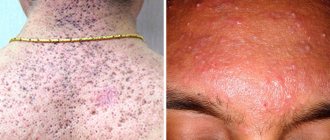Diseases of the heart and blood vessels.
According to statistics, about a third of all cases of cardiovascular disease in people under 65 years of age are associated with smoking. Tobacco use damages the heart muscle and blood vessels and increases the risk of developing the following common and often fatal diseases:
Stroke. For smokers under 65 years of age, the risk of stroke is three times higher than for non-smokers of the same age.
Peripheral vascular diseases. This is a narrowing of the arteries of the lower extremities, which can lead to their blockage and disruption of blood supply to the tissues of the legs. Sometimes peripheral vascular disease can cause amputation. Smoking is the main risk factor for these diseases. In addition, it is smokers who are characterized by the so-called intermittent claudication - a symptom complex that represents periodic pain caused by impaired blood supply to the lower extremities.
An abdominal aortic aneurysm is a rupture of the largest artery leading from the heart. Often leads to sudden death, and tobacco use is a major risk factor for this condition.
When combined with birth control pills, smoking increases the risk of heart attack and stroke in women. This risk increases sharply with age and women over 35 are especially at risk.
Diseases caused by smoking and smokeless tobacco use
There is no safe way to use tobacco.
So-called “smokeless” options, including snus, chewing tobacco and snuff, are also harmful to the body. But the most serious harm is caused by the most popular method of consumption - smoking. This includes smoking cigarettes, cigarillos, kreteks, hookahs, bidis, rolling papers, electronic vaporizers, and tobacco heating systems. What are the dangers of using tobacco?
- Cardiovascular diseases - heart attack, stroke and others - are the cause of every third death on the planet. The risk of developing a stroke in smokers is twice as high as in non-smokers, and a heart attack is four times higher. Tobacco causes blood clots and plaques to form in the coronary arteries. Deterioration of blood supply to a limb can lead to gangrene, which means the need for amputation of the limb to save life.
- Cancer of the mouth and throat. The first is extremely lethal: in many cases, the life of a cancer patient does not exceed five years, and treatment involves facial deformation, loss of the ability to swallow, chew and speak. After surgical removal of a tumor from the larynx, the patient may require a tracheostomy - the installation of a tube to replace the lost esophagus.
- Lung cancer is the most common and one of the most lethal diseases among smokers: compared to non-smokers, addicts have a 22-fold increased risk of developing lung cancer. Smoking is the leading cause of lung cancer, both in active smokers and passive smokers who are regularly exposed to smoke at work and at home.
- Chronic obstructive pulmonary disease (COPD) develops in every fifth smoker: this is 3-4 times more common than in non-smokers. Adolescents who become addicted before their lungs are fully formed are at particular risk. Due to COPD, a person loses the ability to normally inhale oxygen and exhale carbon dioxide, so many patients are forced to resort to the constant use of oxygen masks.
- Tuberculosis. A quarter of the world's population has latent tuberculosis, and smoking doubles the risk of the disease becoming active. This pathology seriously affects the lungs, leading to deterioration of respiratory function, loss of performance and death from respiratory failure.
- Erectile dysfunction and other reproductive diseases are much more common in smokers than in non-smokers. Tobacco smoking leads to poor blood circulation, which is necessary for a normal erection. Women go through menopause earlier because tobacco inhibits the formation of eggs. Women who smoke have more painful menstruation.
- Congenital defects in infants, fetal death and sudden infant death syndrome (SIDS). It is known that smoking during pregnancy leads to numerous fetal pathologies due to DNA damage and deterioration of sperm morphology. The risk of having a child with a cleft lip or cleft palate is much higher for smoking parents than for non-smoking parents.
- Loss of vision and hearing. Statistically, smokers have a higher risk of developing age-related macular degeneration, which leads to deterioration or even complete loss of vision, and a higher risk of cataracts and glaucoma. Constant exposure to smoke leads to dry eye syndrome. Smokers often develop hearing problems, which is associated with a deterioration in the blood supply to the cochlea.
- The immune system of smokers works worse than that of non-smokers. People with a genetic predisposition to autoimmune diseases are at particular risk: smoking can lead to the development of Crohn's disease, rheumatoid arthritis, and various infectious diseases. Smokers are much more likely to suffer from colds and infectious diseases, including pulmonary diseases. HIV-infected smokers have a 12.5-year reduction in life expectancy compared to non-smokers when receiving antiretroviral therapy.
- Gastrointestinal diseases - gastritis, ulcers, Crohn's disease, cancer of the stomach and intestines - are much more common in people addicted to smoking than in those who do not smoke at all.
- Dental diseases. The tar and nicotine contained in a cigarette cause severe damage to teeth, and the first thing a smoker pays attention to is yellowing of the enamel. However, this is not all: after aesthetic problems come functional ones: ulcerative necrotic gingivostomatitis of the gums develops, which leads to periodontitis and periodontal disease. These conditions are accompanied by bleeding gums, increased salivation, persistent bad breath and a coppery taste. A characteristic disease of smokers is nicotine stomatitis - pathological keratinization of the tissues of the upper palate.
It is important to understand that smoking impairs blood circulation, and this entails damage to bone tissue, deterioration of the condition of the skin, hair and nails. Tobacco smoke is extremely toxic, but tobacco in any form is toxic.
Respiratory diseases.
First of all, tobacco smoke enters the respiratory organs and affects them. Tars and other toxic substances contained in tobacco combustion products lead to chronic diseases of the respiratory tract.
Chronic obstructive pulmonary disease - damage to the alveoli and small bronchi. This disease is extremely rare in non-smokers, it is very severe and, most importantly, irreversible. So far, medicine can only slow down its development.
Chronical bronchitis. Its main symptoms are a regular cough and increased sputum production. Occurs in approximately half of heavy smokers.
Decreased lung function. A person who smokes cannot breathe as deeply and efficiently as a non-smoker, which means that their body receives much less oxygen.
Signs of a “smoker's face”
An experienced heavy smoker can be recognized by sight, since it is on the face that all the consequences of an addiction appear most clearly. The term “smoker's face” was coined more than 30 years ago by the famous English doctor Douglas Model. He was able to scientifically prove that nicotine negatively affects the condition of blood vessels. Under the influence of toxins, the vascular wall contracts, especially the blood vessels in the facial area.
Carbon monoxide produced in the body as a result of smoking a cigarette displaces the oxygen needed to maintain normal skin condition. Its structure and color change due to insufficient supply of nutrients.
Clear signs of nicotine addiction appear more and more clearly on the face:
- A clearly defined nasolabial fold, deep facial wrinkles extending from the corners of the mouth.
- A clearly defined network of wrinkles located near the eyes (“crow’s feet”).
- Unhealthy skin color - from pale gray to bluish-red (due to malnutrition).
- Sharply defined contour of the cheekbones.
- Pronounced bags, circles under the eyes - they can be purple, blue, reddish, light brown.
Taken together, all these signs indicate adherence to a bad habit, and it is sometimes very difficult to get rid of them, even after quitting smoking.
Deterioration of reproductive function.
Smoking reduces the chances of conceiving and at the same time increases the risk of ectopic pregnancy and miscarriage.
Tobacco use increases the frequency of painful menstruation and menstrual irregularities. Statistics show that menopause occurs earlier in women who smoke.
In addition, smoking during pregnancy disrupts the normal intrauterine development of the fetus. This leads to the baby being born prematurely, with low weight and other complications. Nicotine can also trigger premature labor and increase the risk of bleeding during labor. Researchers have linked tobacco use during pregnancy to the subsequent development of obesity in the unborn child.
Men who smoke have an increased risk of developing erectile dysfunction, that is, decreased potency. In addition, heavy smokers often experience a decrease in the volume of sperm produced, the number of sperm in the ejaculate, and a deterioration in the overall quality of sperm, which negatively affects a man’s reproductive potential.
How a cosmetologist can help
Having quit smoking, many people think about how to restore health to their skin. Recovery will take a lot of time and effort; skin care must be regular and comprehensive. You should not expect an immediate effect, the main thing is to start the regeneration process, adhering to certain recommendations. First of all, it is necessary to normalize the daily diet by including a large amount of foods containing vitamins E and C. Vegetables and fruits will help improve the condition of the skin - they should only be consumed fresh. But it is better to refrain from eating fatty, fried foods, canned food and smoked meats, since such dishes have a negative effect on metabolism. And digestive problems inevitably affect the condition of the skin.
In heavy smokers, the skin condition worsens so much that it is impossible to cope with these problems on your own. In this case, you cannot do without the help of cosmetologists. A set of procedures will help restore the firmness and elasticity of the skin and improve complexion. The most popular of them is Botox injections. But if a non-smoker needs one procedure to achieve the desired result, a smoker will need at least three. The positive result from Botox will quickly disappear if, after visiting a cosmetologist, you take up a cigarette again. If the procedure is carried out frequently, the skin will get used to the drug and stop reacting to it.
A procedure such as mechanical peeling or microdermabrasion will help renew the skin. The surface of the face is polished using microcrystals, the result is smooth skin and improved complexion. Dark circles under the eyes are usually more difficult to remove, but they can be disguised with the help of high-quality professional cosmetics.
Decreased immune system functions.
Smokers are more susceptible to bacterial and viral infections. Most often, those that affect the respiratory system, ranging from the common cold and flu, ending with Legionnaires' disease (a severe infectious disease with a high mortality rate that affects the lungs, central nervous system, and digestive organs) and tuberculosis. In addition, tobacco use increases the risk of contracting certain sexually transmitted diseases, such as the human papillomavirus.
Smoking increases the risk of developing autoimmune diseases, including rheumatoid arthritis, systemic lupus erythematosus and multiple sclerosis.
Is smokeless tobacco use dangerous?
The safety of snuff and chewing tobacco is a dangerous misconception. The chemical composition of these products is similar to smoking types of tobacco products, and therefore causes the same devastating harm to the body. About 70 substances included in smoking tobacco products are carcinogenic. There are 28 such toxic substances in smokeless tobacco products.
Quitting smoking significantly reduces the risk of developing the diseases listed above, and in the case of some diseases - for example, stroke - it can be brought to the level of a person who has never smoked.
Smoking and using tobacco products in other ways is accompanied by a serious blow to the entire body. A smoker spends exorbitant amounts of money to harm himself. You can refuse this - and within a couple of weeks you will begin to feel better, because lung function will improve, combustion products will disappear from the blood, and shortness of breath will disappear.
It is never too late to start treatment for nicotine addiction. You can take the first step by scheduling a consultation with a specialist at our clinic.
Neurological disorders.
Smoking causes an increased risk of developing Alzheimer's disease and dementia (acquired dementia associated with cerebrovascular accident).
Statistics show that hearing loss, loss of smell and sleep disturbances are often associated with tobacco use.
- "21st Century Could See a Billion Tobacco Victims" (PDF). Tobacco News Flash (Tobacco-Free Missouri Coalition) 3 (12): 1. 2007. Retrieved 2012-05-06. https://ws.missouristate.edu/breatheeasymo/upload/Newsletters/Newsletter62.pdf
- "Lung Cancer and Smoking" (PDF). Fact Sheet. www.LegacyForHealth.org. 2010-11-23. Retrieved 2012-05-06.
- According to the US National Institute on Drug Abuse. https://www.drugabuse.gov/publications/research-reports/tobacco/what-are-medical-consequences-tobacco-use/.
- Joyce JW (May 1990). "Buerger's disease (thromboangiitis obliterans)". Rheumatic Diseases Clinics of North America 16(2):463–70.
- Lederle FA, Larson JC, Margolis KL, Allison MA, Freiberg MS, Cochrane BB, Graettinger WF, Curb JD (2008). "Abdominal aortic aneurysm events in the women's health initiative: cohort study." BMJ 337:a1724.
- Devereux G (May 2006). ABC of chronic obstructive pulmonary disease. Definition, epidemiology, and risk factors". BMJ 332(7550):1142–1144.
- Ward C, Lewis S, Coleman T (2007). "Prevalence of maternal smoking and environmental tobacco smoke exposure during pregnancy and impact on birth weight: retrospective study using Millennium Cohort." BMC Public Health 7: 81.
- Peate I (2005). "The effects of smoking on the reproductive health of men." British Journal of Nursing 14 (7): 362–366.
- Johnson GK, Slach NA (Apr 2001). "Impact of tobacco use on periodontal status." Journal of Dental Education 65(4): 313–21.
- Jha P, Jacob B, Gajalakshmi V, Gupta PC, Dhingra N, Kumar R, Sinha DN, Dikshit RP, Parida DK, Kamadod R, Boreham J, Peto R (Mar 2008). "A nationally representative case-control study of smoking and death in India." The New England Journal of Medicine 358(11): 1137–1147.
- Almeida OP, Hulse GK, Lawrence D, Flicker L (Jan 2002). "Smoking as a risk factor for Alzheimer's disease: contrasting evidence from a systematic review of case-control and cohort studies." Addiction 97(1):15–28.
Skin care rules
To restore the skin, both single procedures and complex measures are prescribed, involving a combination of several techniques. Which of them are suitable for a particular person depends on many factors, including the severity of negative changes in the skin. And if it is enough for one to undergo a course of injection procedures (for example, mesotherapy), then another will need longer treatment using phonophoresis, laser therapy, ultrasound peeling, etc.
Skin care should also be individual and consist of several stages:
- Using foam or cosmetic milk to thoroughly cleanse the surface of the face.
- Increasing skin tone with lotion or tonic.
- Deep cleansing of the skin, for which special gommages and scrubs are used. You can also use an enzyme peel to remove any old cells. This will prepare the skin for the deepest penetration of beneficial substances contained in nourishing creams.
- Gently massage the skin using creams and oils - they are selected taking into account the specifics of the skin.
- Applying nourishing creams to the skin of the face, which at the same time have a moisturizing effect.
- From time to time it is necessary to make masks using products that promote a deeper supply of nutrients.
- The use of products that restore the protective properties of the skin.
It is important to choose the right products so that skin restoration occurs in two directions. The first is a rapid improvement in the appearance of the skin through the use of active ingredients. They not only cleanse, nourish and moisturize the skin, but also protect it from harmful factors, including tobacco smoke. The second direction is therapeutic, it consists of a deeper effect on the epidermis. As a result of exposure to special components, the natural skin restoration mechanism is launched.
What allows you to achieve a complex effect:
- The skin's own immunity is restored.
- The regenerative abilities of skin cells improve.
- The process of synthesis of your own collagen, elastin, and glycosaminoglycans is normalized.
- The cells that make up the basal epidermal layer begin to actively divide, stabilizing the process of skin renewal.
- Antioxidants entering the skin stimulate the elimination of toxins and free radicals formed as a result of smoking.
In some cases, it is impossible to do without hardware techniques that effectively complement and enhance the effect of care procedures. As a result, the penetration of beneficial components from cosmetic products into the skin improves. For this purpose, specialists prescribe photo- and phonophoresis, oxymesotherapy, ionogalvanotherapy, and microcurrent therapy. Vascular defects on the face can be corrected using laser coagulation, photo- or electrotherapy.
Sign up for the procedure right now
Signs that your child has started smoking
A beginning smoker—a teenager or a student—is no different from his non-smoking peers. Cigarettes can be hidden, and external changes will appear later. For now, it can only be recognized by its smell. The smell of tobacco is very persistent and lingers in the hair and on clothes for a long time. You can hide it by bathing in cologne and body sprays.
Therefore, if your child suddenly becomes incredibly clean, and afterward there is a dense wall of aroma in the room for a long time, this is an alarming signal. You can ask directly, but the chance of getting an honest answer is inversely proportional to the chance of hearing something like the classic: “The guys were smoking, and I was just standing next to it.”
But bad breath, which suddenly becomes unpleasant, can become a reason for a serious conversation about the consequences of smoking. Identifying a new smoker is just as easy: if a child suddenly becomes interested in mouth rinses or starts buying chewing gum on an industrial scale, this may be an attempt to get rid of the smell... Or to please someone.
An unpleasant odor should be considered in combination with other signs that may indicate addiction: cough, wheezing, weakened immunity. However, this may also mean that the child needs to be seen by a doctor.
Modern teenagers increasingly prefer vapes and tobacco heaters to ordinary cigarettes, which completely relieve the consumer of the unpleasant odor - even vice versa. Unfortunately, according to scientists, devices and liquids are just as harmful to them, especially at a young age. And the lack of certificates of conformity makes the result of using vapes unpredictable.
Experts recommend that parents be on guard - unusual smells in the room and small objects resembling flash drives can give away a young vaper. In this case, it is recommended to calmly talk with your child about how electronic cigarettes and vaping affect teenagers.
If a teenager starts smoking, you need to try to convince him to give up this activity and try to wean him off smoking before it develops into an addiction and habit.
At this moment, it is important not to threaten or issue ultimatums. Find common ground, understand the motives and talk about how this will affect his future. Together you can calculate how much money will be spent on cigarettes, explain how to refuse in order to maintain your dignity, and if you smoke yourself, set an example and quit.









